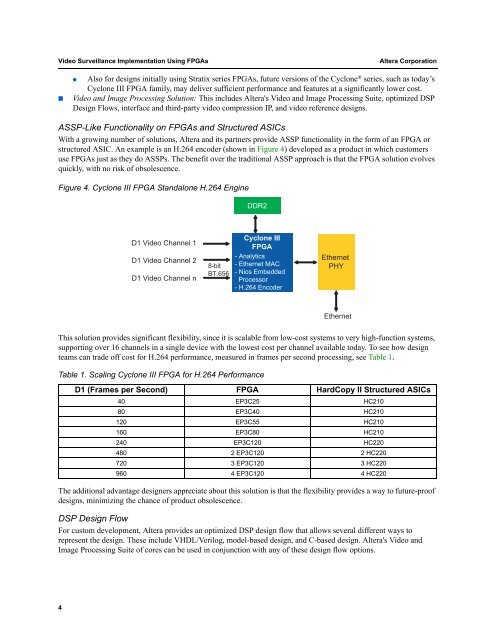Video Surveillance Implementation Using FPGAs - Altera
Video Surveillance Implementation Using FPGAs - Altera
Video Surveillance Implementation Using FPGAs - Altera
You also want an ePaper? Increase the reach of your titles
YUMPU automatically turns print PDFs into web optimized ePapers that Google loves.
<strong>Video</strong> <strong>Surveillance</strong> <strong>Implementation</strong> <strong>Using</strong> <strong>FPGAs</strong> <strong>Altera</strong> Corporation<br />
● Also for designs initially using Stratix series <strong>FPGAs</strong>, future versions of the Cyclone ® series, such as today’s<br />
Cyclone III FPGA family, may deliver sufficient performance and features at a significantly lower cost.<br />
■ <strong>Video</strong> and Image Processing Solution: This includes <strong>Altera</strong>'s <strong>Video</strong> and Image Processing Suite, optimized DSP<br />
Design Flows, interface and third-party video compression IP, and video reference designs.<br />
ASSP-Like Functionality on <strong>FPGAs</strong> and Structured ASICs<br />
With a growing number of solutions, <strong>Altera</strong> and its partners provide ASSP functionality in the form of an FPGA or<br />
structured ASIC. An example is an H.264 encoder (shown in Figure 4) developed as a product in which customers<br />
use <strong>FPGAs</strong> just as they do ASSPs. The benefit over the traditional ASSP approach is that the FPGA solution evolves<br />
quickly, with no risk of obsolescence.<br />
Figure 4. Cyclone III FPGA Standalone H.264 Engine<br />
This solution provides significant flexibility, since it is scalable from low-cost systems to very high-function systems,<br />
supporting over 16 channels in a single device with the lowest cost per channel available today. To see how design<br />
teams can trade off cost for H.264 performance, measured in frames per second processing, see Table 1.<br />
Table 1. Scaling Cyclone III FPGA for H.264 Performance<br />
The additional advantage designers appreciate about this solution is that the flexibility provides a way to future-proof<br />
designs, minimizing the chance of product obsolescence.<br />
DSP Design Flow<br />
For custom development, <strong>Altera</strong> provides an optimized DSP design flow that allows several different ways to<br />
represent the design. These include VHDL/Verilog, model-based design, and C-based design. <strong>Altera</strong>'s <strong>Video</strong> and<br />
Image Processing Suite of cores can be used in conjunction with any of these design flow options.<br />
4<br />
D1 <strong>Video</strong> Channel 1<br />
D1 <strong>Video</strong> Channel 2<br />
D1 <strong>Video</strong> Channel n<br />
8-bit<br />
BT.656<br />
DDR2<br />
Cyclone III<br />
FPGA<br />
- Analytics<br />
- Ethernet MAC<br />
- Nios Embedded<br />
Processor<br />
- H.264 Encoder<br />
Ethernet<br />
PHY<br />
Ethernet<br />
D1 (Frames per Second) FPGA HardCopy II Structured ASICs<br />
40 EP3C25 HC210<br />
80 EP3C40 HC210<br />
120 EP3C55 HC210<br />
160 EP3C80 HC210<br />
240 EP3C120 HC220<br />
480 2 EP3C120 2 HC220<br />
720 3 EP3C120 3 HC220<br />
960 4 EP3C120 4 HC220
















